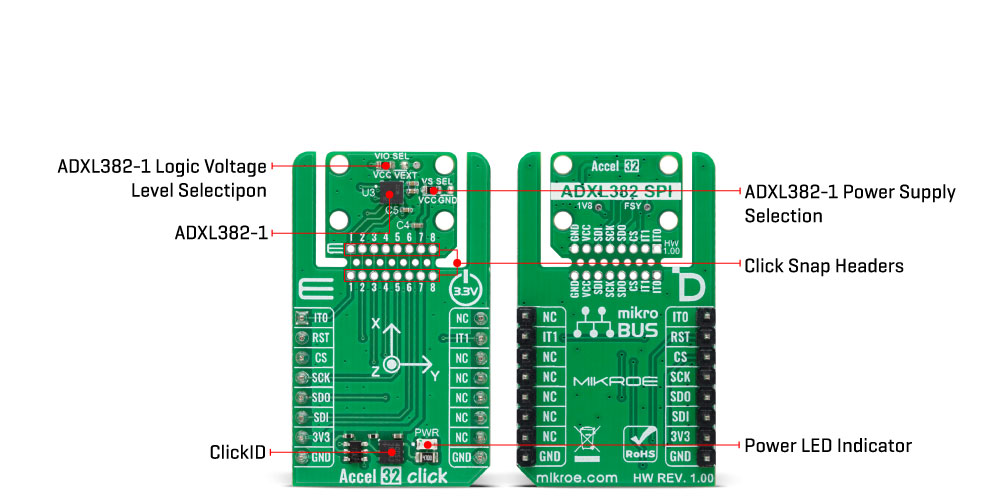OFF
GO LOCAL
| Company | Stock | Price |
|---|---|---|

MIKROE-6565
16 g
Status:
Accel 32 Click is a compact add-on board for precise motion detection and monitoring applications. This board features the ADXL382-1, a wide bandwidth 3-axis MEMS accelerometer from Analog Devices. It offers user-selectable measurement ranges of ±15g, ±30g, and ±60g with high sensitivity, low noise density, and efficient power consumption, making it suitable for demanding environments with high vibrations. It uses an SPI interface for communication, integrated temperature sensing, and single, double, and triple tap detection with false trigger prevention. The board supports the Click Snap feature, providing flexible mounting options and additional functionality through configurable interrupts and power management. Accel 32 Click is ideal for condition-based monitoring, structural health monitoring, seismic imaging, robotics, audio and active noise cancellation, wearables, and other low-power motion detection applications.
Accel 32 Click is fully compatible with the mikroBUS™ socket and can be used on any host system supporting the mikroBUS™ standard. It comes with the mikroSDK open-source libraries, offering unparalleled flexibility for evaluation and customization. What sets this Click board™ apart is the groundbreaking ClickID feature, enabling your host system to seamlessly and automatically detect and identify this add-on board, alongside a Click Snap feature introducing a new level of flexibility and ease of use.
This product is no longer in stock
Availability date:
OFF
| Company | Stock | Price |
|---|---|---|

Accel 32 Click is based on the ADXL382-1, a low noise, low power, wide bandwidth, 3-axis MEMS accelerometer from Analog Devices designed for precise motion detection and monitoring applications. This advanced accelerometer offers exceptional measurement accuracy, supporting selectable ranges of ±15g, ±30g, and ±60g, ensuring flexibility across different use cases. The sensitivity varies accordingly, providing 2000LSB/g at ±15g and decreasing to 500LSB/g at ±60g, allowing users to tailor measurements to specific requirements. One of the key advantages of the ADXL382-1 is its industry-leading noise performance, making it an ideal solution for precision applications like condition-based monitoring, structural health monitoring, seismic imaging, robotics, audio and active noise cancellation (ANC), and more requiring minimal calibration effort.

Thanks to its low noise density and power consumption, the ADXL382-1 excels in environments where precise motion capture is required, such as measuring audio signals or detecting heart sounds, even amidst strong vibrations. The version implemented on this board, ADXL382-1BCCZ-RL7, uses an SPI interface for fast and reliable data transfer and communication with the host MCU. Alongside its primary motion sensing capabilities, the ADXL382-1 integrates several advanced features that enhance its overall functionality. These include an integrated micropower temperature sensor for environmental monitoring and built-in single, double, and triple tap detection mechanisms supported by a state machine designed to prevent false triggering.
This Click board™ is designed in a unique format supporting the newly introduced MIKROE feature called "Click Snap." Unlike the standardized version of Click boards, this feature allows the main sensor area to become movable by breaking the PCB, opening up many new possibilities for implementation. Thanks to the Snap feature, the ADXL382-1 can operate autonomously by accessing its signals directly on the pins marked 1-8. Additionally, the Snap part includes a specified and fixed screw hole position, enabling users to secure the Snap board in their desired location.
Accel 32 Click communicates with the host MCU via a 4-wire SPI interface, supporting a maximum clock frequency of 8MHz, ensuring efficient and reliable data transfer. In addition to the SPI interface, the board includes two configurable interrupt pins, IT0 and IT1, which act as an event-detection interrupt, essential for reliable motion-activated features. These include data-ready interrupts, generic interrupts like any or no-motion detection, free-fall detection, and tap detection. On the back side of the board, an additional signal from the ADXL382-1 is provided through the FSY test point, which serves as an interrupt input in FIFO trigger mode. This signal is optional, allowing users to use it for additional functionalities.
The Snap section of the board includes two jumpers, VIO SEL and VS SEL, which provide flexible power configuration options for the ADXL382-1. The VIO SEL jumper allows users to select the logic voltage for the ADXL382-1, offering a choice between a fixed 3.3V supply from the mikroBUS™ 3V3 power rail or an external power supply ranging from 1.14V to 3.6V. When using an external power source, the VIO SEL jumper must be set to the VEXT position, with the external voltage applied through the VEXT test point. The VS SEL jumper controls the power supply for the ADXL382-1's internal circuitry; when set to the VCC position, the ADXL382-1 uses its internal LDO regulators to generate a nominal 1.8V output, accessible via the 1V8 test point on the back of the board. Switching the VS SEL jumper to the GND position disables the internal LDO regulators, enabling users to supply the 1V8 pin externally, providing power for the internal analog and digital logic.
This Click board™ can be operated only with a 3.3V logic voltage level. The board must perform appropriate logic voltage level conversion before using MCUs with different logic levels. It also comes equipped with a library containing functions and example code that can be used as a reference for further development.
Click Snap is an innovative feature of our standardized Click add-on boards, introducing a new level of flexibility and ease of use. This feature allows for easy detachment of the main sensor area by simply snapping the PCB along designated lines, enabling various implementation possibilities. For detailed information about Click Snap, please visit the official page dedicated to this feature.
Type
Acceleration,Motion
Applications
Ideal for condition-based monitoring, structural health monitoring, seismic imaging, robotics, audio and active noise cancellation, wearables, and other low-power motion detection applications
On-board modules
ADXL382-1 - wide bandwidth 3-axis MEMS accelerometer from Analog Devices
Key Features
Selectable measurement ranges, low noise density and low power consumption, SPI interface with up to 8MHz, integrated temperature sensor and motion detection (single, double, triple tap), FSY interrupt input for FIFO trigger mode, Click Snap feature, configurable interrupts, and more
Interface
SPI
Feature
Click Snap,ClickID
Compatibility
mikroBUS™
Click board size
M (42.9 x 25.4 mm)
Input Voltage
3.3V,External
This table shows how the pinout on Accel 32 Click corresponds to the pinout on the mikroBUS™ socket (the latter shown in the two middle columns).
| Label | Name | Default | Description |
|---|---|---|---|
| LD1 | PWR | - | Power LED Indicator |
| JP1 | VIO SEL | Left | ADXL382-1 Logic Voltage Level Selection VCC/VEXT: Left position VCC, Right position VEXT |
| JP2 | VS SEL | Left | ADXL382-1 Power Supply Selection VCC/GND: Left position VCC, Right position GND |
| Description | Min | Typ | Max | Unit |
|---|---|---|---|---|
| Supply Voltage | - | 3.3 | - | V |
| External Power Supply | 1.14 | - | 3.6 | V |
| Measurement Range | ±15 | - | ±60 | g |
| Sensitivity | 500 | - | 2000 | LSB/g |
Accel 32 Click demo application is developed using the NECTO Studio, ensuring compatibility with mikroSDK's open-source libraries and tools. Designed for plug-and-play implementation and testing, the demo is fully compatible with all development, starter, and mikromedia boards featuring a mikroBUS™ socket.
Example Description
This example demonstrates the use of Accel 32 Click board by reading and displaying the accelerometer data (X, Y, and Z axis) and a temperature measurement in degrees Celsius.
Key Functions
accel32_cfg_setup This function initializes Click configuration structure to initial values.accel32_init This function initializes all necessary pins and peripherals used for this Click board.accel32_default_cfg Click Default Configuration function.accel32_set_accel_fsr This function sets the accel measurement full scale range.accel32_get_data This function reads both accelerometer and temperature data from the device.Application Init
Initializes the driver and performs the Click default configuration.
Application Task
Reads the accelerometer and temperature measurements. The results are displayed on the USB UART every 100 ms.
Application Output
This Click board can be interfaced and monitored in two ways:
Additional Notes and Information
The complete application code and a ready-to-use project are available through the NECTO Studio Package Manager for direct installation in the NECTO Studio. The application code can also be found on the MIKROE GitHub account.
NOTE: Please be advised that any peripheral devices or accessories shown connected to the Click board™ are not included in the package. Check their availability in our shop or in the YMAN section below.